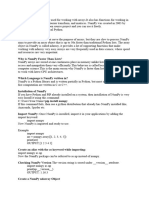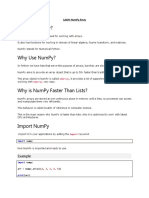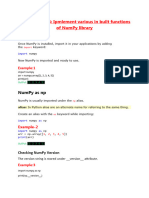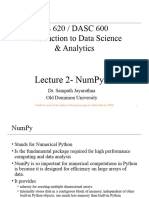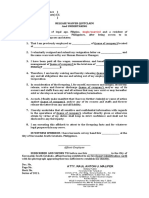0% found this document useful (0 votes)
30 views17 pagesNum Py
NumPy is a Python library for efficient array manipulation, offering functions for linear algebra and other mathematical operations. It provides an array object called ndarray, which is significantly faster than traditional Python lists due to its continuous memory storage. NumPy is open-source, created in 2005, and is widely used in data science for its performance advantages.
Uploaded by
arvind.kumarCopyright
© © All Rights Reserved
We take content rights seriously. If you suspect this is your content, claim it here.
Available Formats
Download as DOCX, PDF, TXT or read online on Scribd
0% found this document useful (0 votes)
30 views17 pagesNum Py
NumPy is a Python library for efficient array manipulation, offering functions for linear algebra and other mathematical operations. It provides an array object called ndarray, which is significantly faster than traditional Python lists due to its continuous memory storage. NumPy is open-source, created in 2005, and is widely used in data science for its performance advantages.
Uploaded by
arvind.kumarCopyright
© © All Rights Reserved
We take content rights seriously. If you suspect this is your content, claim it here.
Available Formats
Download as DOCX, PDF, TXT or read online on Scribd
/ 17
